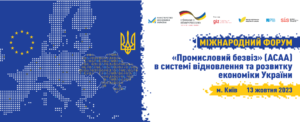
The Ministry of Economy invites you to participate in the international forum “Industrial Visa Waiver (ASAA) in the System of Economic Recovery and Development of Ukraine”.
The forum is organized at the initiative of the Department of Technical Regulation within the framework of the international cooperation project ReACT4UA, with funding from the German government and with the support of the German federal company Deutsche Gesellschaft für Internationale Zusammenarbeit (GIZ) GmbH and the public union “Foundation for Support of Reforms in Ukraine”.
Date of the event: October 13, 2023.
Registration: 9:00 – 10:00 Kyiv time.
Registration is required. Online registration is available here.
Start: 10:00 a.m. Kyiv time.
Format: online/free of charge.
Simultaneous translation (English/Ukrainian) will be provided.
The main objective: to consider the Agreement on Conformity Assessment and Acceptance of Industrial Products (ACAA Agreement, or the so-called “industrial visa-free regime”) as a factor in overcoming technical barriers to trade, increasing the competitiveness of small and medium-sized enterprises and restoring Ukraine’s economy in general during the war and post-war period.
Key objectives: to hear business priorities and outline ways to create a unified European business environment where each participant will be able to establish communications to find partners.
Two sessions:
Session 1: “Ukraine’s quality infrastructure in the European coordinate system: economic recovery and development”;
II session: “Dialogue with Ukrainian and EU businesses on practical aspects of internationalization of enterprises.
Participation in the Forum is a great opportunity for businesses to get guidance on the movement of industrial goods, search for reliable partners in areas where countries have accumulated significant human and production potential.
Representatives of the following are invited to participate in the Forum:
state-owned enterprises, institutions, organizations operating in the field of technical regulation, standardization, metrology and metrological activities
manufacturers and businesses interested in the production and export of industrial products of Ukraine
other interested parties.
The official media partner is Interfax-Ukraine.
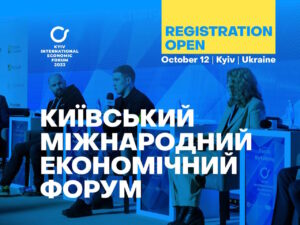

On October 12, 2023, the ninth Kyiv International Economic Forum, an annual event that brings together representatives of the Ukrainian government, business, and society for open dialogue, exchange of experience, creation of a space of trust, and effective strategies for economic development, will take place.
For the second time, the forum will be held in Kyiv under martial law. The theme of this year’s KIEF is “People. Business. Economy. The Price of Freedom”.
Key topics of KIEF 2023:
“In times of the most difficult historical challenge for the country, its economy, business, society, and for each of us personally, we must unite, combine our efforts and experience to make complex, bold, and pragmatic decisions. The goal is to become co-authors not only of the Victory, but also of the future of an independent, innovative, and prosperous Ukraine that our descendants will be proud of. It all depends on us,” commented Vasyl Khmelnytsky, initiator of the forum and founder of UFuture holding.
70+ speakers will share their experience and vision, including:
“Last year, we discussed the topic of restoring the Ukrainian economy after the victory. But life turned out to be much more complicated and the challenges much more serious. KIEF 2023 is dedicated to finding solutions to the most pressing ones that need to be addressed here and now. The high price of Ukraine’s freedom and independence must be justified. This is a task for each of us,” said Yuriy Pyvovarov, CEO of the Kyiv International Economic Forum.
“Despite the war, Ukrainian business continues to operate, supporting the army and humanitarian initiatives. This year’s KIEF is an opportunity to discuss the problems, solutions and tools for integrating veterans into civilian life. It is an opportunity to share experience of doing business during the war and join forces on the way to victory. An opportunity to record our achievements and plan the next steps. This is a crucial event where Superhumans Center has a platform for a joint discussion on how to build a new social contract between people returning from war and business,” said Olga Rudneva, CEO of Superhumans Center.
As part of the event, each participant will be able to contribute to the support of the Superhumans Center for Rehabilitation, Prosthetics and Reconstructive Surgery. The proceeds from the registration fees will be used to rehabilitate Ukrainians affected by the war.
On the day of the event, the KIEF YouTube channel will broadcast the event via the link.
The innovative partner of the event and the exclusive partner of the online broadcast is Mastercard.
Strategic partner: UFuture.
Title partners: Nova Poshta; AJAX; Biopharma; Naftogaz; Federation of Employers of the Oil and Gas Industry; Smart-Holding.
Partners: Kyivstar, AEQUO, Dynasty Investment Group, Interpipe, Epicenter, MHP, Biosphere, PUMB, QP, Neqsol Holding, PrivatBank, DTEK, CEO Club, Work.ua, Superhumans Center, All-Ukrainian Mental Health Program “How are you?”, NGO “Bezbarernist”, Osvitoria.
Analytical partner: Gradus.
Title media partners: Starlight Media, 1+1 Media.
Official media partner of the Forum: Interfax-Ukraine.
Media partners: We Are Ukraine, Delo, The Page, Mind, The Kyiv Independent, TAVR media, Huxley.
We believe that our victory, our recovery and economic development is our choice and our business.
Join the change on October 12.
For more information about the event and conditions of participation, please follow the link.
Kyiv International Economic Forum 2023
People. Business. Economy
The price of freedom
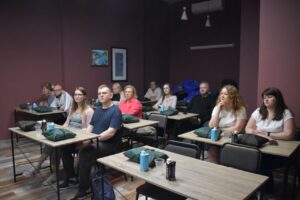
With the start of the new school year, new rules came into force in Ukraine, providing for different training regimes depending on the level of security in different regions. These measures were introduced in response to the high level of danger.
Taking into account the current situation and the importance of ensuring the safety of pupils and students, the Experts Club training and analysis center in Kyiv organized a training seminar on pre-medical assistance for teachers. The training, which took place on September 29 in Kyiv, was designed to provide teachers with the necessary skills to provide first aid in case of wounds and injuries.

The seminar was organized by the Experts Club think tank and medical partner Adonis. The seminar was also supported by the charity organization Hromada Priirpeniya Foundation and information support from Interfax-Ukraine news agency and Open4business portal.
The main presenter of the training was Maryana Bolyuk, an anesthesiologist and representative of the Adonis group of medical centers. Maryana is a co-author of 12 scientific publications and has rich experience in the field of medicine.

During the seminar, teachers and educators received not only theoretical knowledge, but also practical skills necessary to provide first aid to children in various situations. Among the main topics covered were:
1. Basics of pre-medical care: The workshop participants learned the basic principles and steps to follow when providing first aid, including assessing the situation, ensuring safety, calling for emergency medical assistance and providing emergency interventions.
2. Treating different types of wounds and injuries: Trainers learned how to properly treat wounds, stop bleeding, fix fractures, and treat bruises and sprains.
3. Pre-medical care for children: Teachers gained specialized knowledge on first aid for children, taking into account their body characteristics and emotional reactions.
4. Practical exercises: Practical exercises were an important part of the workshop, including modeling different situations and practicing first aid skills.
Training teachers and educators in first aid for children with injuries and trauma is an important initiative to promote safety in educational institutions. Experts Club and Adonis will continue to support such educational initiatives to ensure the highest level of safety in educational institutions of Ukraine.
Maksym Urakin, founder of Experts Club, emphasized that teachers play a key role in children’s lives and knowledge of pre-medical care skills is a part of education that can save lives.

“Such workshops help teachers not only feel more confident in emergency situations, but also provide them with the opportunity to teach their students the basics of first aid, which is also an important skill for everyone,” Urakin noted.
The training was attended by university professors and school teachers from Kyiv and the Bucha district of Kyiv region.
Oleksandr Golizdra, Chairman of the Committee on Information Policy and Relations with Local Authorities of the Public Council at the Bucha District State Administration, asked the participants to pass on the knowledge and skills gained to their colleagues in educational institutions.
According to Tetyana Lagovska, executive director of the Pryirpin Community Foundation, the main thing in first aid is the efficiency of actions to stabilize the victim’s condition. However, as the volunteer noted, it is also important to adhere to the principle of “do no harm,” so it is important to know what should and should not be done before the arrival of professional doctors.
The participants of the training expressed their gratitude to the organizers and the instructor for the valuable knowledge and experience gained at the training. They also emphasized the importance of such events and hope that such educational seminars will continue in the future. In addition, each participant received as a gift a fully equipped first aid kit for first aid in case of wounds.
The pre-medical care workshop for teachers was an example of how educational institutions and medical partners can collaborate to ensure the safety of students and staff. These efforts will help strengthen the education system and prepare teachers for the variety of challenges they may face in educational institutions in war.

Experts Club and Adonis pledge to continue to support and conduct similar educational initiatives, as they see them as an opportunity to make education safer and encompass not only academic but also life skills.
ADONIS, CLUB_EXPERTS, EDUCATION, FIRST_HELP, FUND_OF_GROMADA_PRIORPENIYA, GOLYZDRA, PRE-MEDICAL_HELP, URAKIN, БОЛЮК

More than 65% of Ukrainians surveyed cannot recall a single brand of domestically produced wine. This is evidenced by the results of a sociological survey conducted by Active Group in cooperation with the Kyiv-based analytical center Experts Club.

Among the domestic wine brands most frequently mentioned by Ukrainians are Koblevo, Shabo, Villa Krym, Bolgrad, Chizay, Kolonist, Inkerman, Oreanda and others. Also, only 30% of respondents have tasted Ukrainian-made craft wine at least once in their lives, and 17% do not know what craft winemaking is.
On the other hand, 54% of respondents would prefer Ukrainian wine if they had to choose a bottle for a visit or a party. At the same time, 47% of respondents prefer Ukrainian alcohol in general, while 27% prefer imported alcohol, and 27% are undecided.

In addition, the survey showed that 30% of citizens do not drink alcohol at all, 28% drink alcohol once a month or less, and 16% drink no more than once a week.

“In wine-growing countries, people are very patriotic about their own products, but in Ukraine, for some reason, sommeliers would rather recommend a foreign product than Ukrainian ones, even though we have quite high-quality craft wines. Therefore, it is necessary to change the worldview and popularize our own production so that the word Ukrainian is synonymous with quality,” said Oleksandr Poznyi, director of Active Group.
In turn, Maxim Urakin, founder of the Experts Club think tank, emphasized the importance of Ukrainian wine in new markets.
“Increasing export volumes is also a good information occasion that will make Ukrainian wine more popular among our consumers. This can be achieved through obtaining international certificates confirming the high quality of Ukrainian wine, as well as through cooperation with well-known winemakers from other countries to improve the skills of Ukrainian winemakers. An example of such cooperation is the assistance to Ukrainian winemaking from the world-famous representative of this industry, Ricardo Fernandez Nunez, owner of the international wine group Vinos de la Luz,” said Urakin.
Volodymyr Pechko, Chairman of the Association of Gardeners, Winegrowers and Winemakers of Ukraine (UKRSADVINPROM), noted that the creation and presentation of new unique varieties and improvement of production technologies could be important factors that will improve the image of Ukrainian craft wine among consumers.
“Ukrainian wineries are increasingly implementing modern wine production technologies. This can be a good reason to hold public events and popularize this product. In particular, UkrSadVinProm has stepped up the use of the latest technologies in the field of planting, processing, cleaning, storage and transportation of wine and wine materials to ensure that Ukrainian fruits and berries meet international quality standards,” said Pechko.
The survey was conducted in July 2023 among Ukrainian citizens aged 18 and older by self-administered questionnaires in the SunFlowerSociology panel.
About 1 thousand respondents – citizens of Ukraine aged 18 and older – took part in the survey, which was conducted online in the SunFlower Sociology panel. The survey program was developed jointly by Experts Club and Active group.
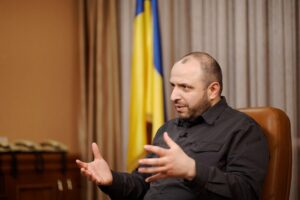
Minister of Defense of Ukraine Rustem Umerov, speaking about the development of the domestic military-industrial complex, said that the visa of Ukraine is to develop a world class of militarized products and services.
“My task is to build a path to victory as a ministry. And now there are several directions regarding the defense-industrial complex. Our vision is to develop a world class of militarized products and services – I’m talking about the defense industry,” Umerov said at a panel discussion at the International Forum of Defense Industries.
The minister noted that Ukraine wants to produce militarized products and services of very high quality that can be scaled up and “cover all of Ukraine’s needs now.”
“And further already after the end of the war to export it,” Umerov emphasized.
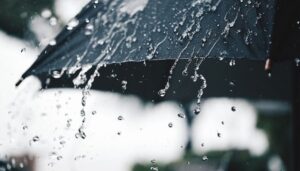
In Ukraine on Sunday, October 1, in the northern, Vinnytsia, at night and western regions, in some places is expected a little short-term rain; in the rest of the territory without precipitation, reports Ukrhydrometcenter.
The wind is predominantly north-westerly, 5-10 m/s, in the western regions in some places gusts of 15-20 m/s.
The temperature at night is 9-14 °, in Crimea and on the seashore 15-20 °; in the afternoon in the western and northern regions 16-21 °, in the rest of the territory 22-27 °.
In Kiev on October 1, a little short-term rain. The wind is northwest, 5-10 m/s.
The temperature at night is 12-14°, during the day about 20°.
According to the Central Geophysical Observatory named after Borys Sreznevsky in Kiev. Borys Sreznevsky in Kiev on October 1, the highest daytime temperature was 26.5° in 1927, the lowest nighttime temperature was -1.9° in 1881.
Monday, October 2, in Ukraine without precipitation.
The wind is north-westerly, 5-10 m/s.
The temperature at night 8-13, in the south 11-16, in the western and northern regions 5-10; in the afternoon 15-20 °, in the south and east 18-23 °.
In Kiev on October 2 without precipitation. The wind is northwest, 5-10 m/s.
The temperature at night is 8-10 ° warm; in the daytime 18-20 °.